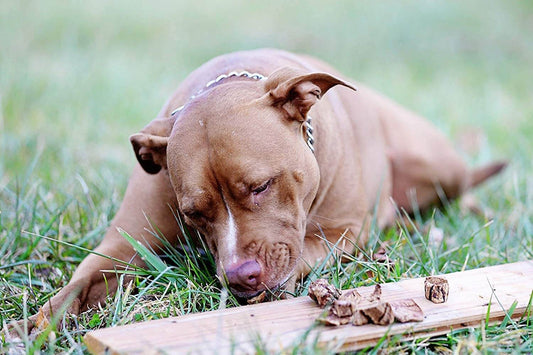
10 Canine Nutrition Myths Debunked: Some Still Believe This!
Dawn Miller Feb 12, 20256 Minute ReadOver the years, I've talked to a lot of dog parents in my dog-loving community. From sharing training tips to helping each other with destructive dog behavior to finding the best dog bones for aggressive chewers, we've discussed it.
But as you can imagine, I've also encountered several pervasive canine nutrition myths. When I do, I'm glad I've taken the time to research and find the truth.
1. Myth: Dogs Get 100% Nutrition from Kibble
Veterinarian-approved kibble attempts to be 100% complete nutrition. And it's definitely better than it used to be.
But it has a glaring problem.
High-heat cooking destroys certain nutrients. So, even if those vitamins and healthy fats were present, they don't reach the dog bowl.
Here are nutrients your dog is lacking on an all-kibble diet because they can't handle the heat:
- Antioxidants. Most of these anti-inflammatory, anti-cancer compounds are destroyed.
- Omega 3. This essential fat is anti-inflammatory and critical for the brain, skin, coat, heart, and immunity. Essential means that dogs can't make it internally. Big loss!
- Omega 6. It's critical for immune function. And dogs can't make it.
- B12. It's vital for energy, mental health, and immunity. Up to 40% of B12 is lost in high-heat cooking.
- Probiotics. These living organisms are essential for gut health, immunity, and mood.
- Vitamin C. Unlike humans, dogs can make it internally but often struggle to make enough.
Also, because kibble ingredients are broken down into a slurry for cooking, they lose the natural structures that would otherwise protect some nutrients.
Kibble can also lack collagen, the structural protein needed for healthy bones, joints and skin. This is not because of the heat but because there isn't a lot of it in the first place.
2. Myth: Wet Food Is Better Nutritionally
In case you're wondering, wet dog food is cooked at the same temperature and made in a similarly destructive way.
Now, to be clear, a good kibble or wet food should be the bulk of a dog's diet. It's almost complete, just not optimal.
Since we're discussing canine nutrition, it's natural to wonder what else I can feed my dog in addition to kibble. Are there some healthy treats for dogs I should look for to fill in the nutrition gaps?
So, let's look at those myths next to find healthy dog treats in a sea of unhealthy options.
3. Myth: Dogs Should Eat the Same Food at Every Meal
It's true that switching up your kibble suddenly can cause tummy troubles. But because kibble and wet food are missing some keys to optimal canine nutrition, it's a good idea to supplement dog nutrition with other dog-safe and nutritious foods, especially those high in nutrients kibble can lack.
For example:
- Bone marrow and connective tissues for collagen B vitamins (and omega 3 & 6 if it's from grass-fed beef)
- Organ meat for vitamin C, collagen, and B vitamins
- Pumpkin, blueberries, and apples for antioxidants
- Plain yogurt for probiotics
- Connective tissues like beef trachea tube for collagen, glucosamine, chondroitin, and hyaluronic acid.
4. Myth: High-Protein Diets Cause Kidney Failure
This myth arose because humans who already have chronic kidney disease (CKD) struggle to process protein, worsening the condition. But there is currently no evidence that high protein can cause kidney problems in those with relatively healthy kidneys.
5. Myth: High Fat Leads to Pancreatitis
Well, first of all. All fat is not the same. The essential fats omega 3 and 6 are generally considered healthy fats. Humans and dogs need them in their diet.
Trans fats are generally bad and have been mostly removed from food supply in the US. Some naturally occurring trans fat is in beef. But it's miniscule compared to what people ate in shortening, cake frosting, and baked goods before this artery-clogging fat was banned in the US.
Saturated fat has a complex reputation. Some are good, and the source matters. It appears that overdoing it may be harmful.
So, ideally, you'd look for something that's higher in healthy fats and lower in saturated fat with next to no trans fat.
Additionally, fat is filling. So, if your dog is filling up on fat, it could spoil their dinner. That could lead to worsening dog health.
So, moderation is key.
The great thing about marrow-filled dog bones is that they last across several chewing sessions. Your dog only gets a little collagen and omega-3-rich marrow at a time.
6. Myth: "Grass Fed" Beef Is a Marketing Gimmick
If you thought this, you're not alone. I'm the same way about "buzz words." I tend to distrust them, so I looked into the research.
As it turns out, grass-fed beef has 2.5X more omega 3 fat than grain-fed cattle—and less saturated fat and trans fat.
Given that omega 3 is so important for both dogs and absent in kibble, I can confidently say, "Buy grass fed beef dog bones and treats". They're worth it!
Your dog deserves what you can give.
7. Myth: Raw Diets Are Always Better
It seems so simple. If high heat destroys nutrition, let's go raw.
But here's the thing: Modern dogs don't have the gut fortitude of a wild dog that regularly eats raw and rotten food.
Dogs have to build up a tolerance to that stuff. And they can get life-threatening sickness while trying.
So, veterinarians discourage raw food diets as a general rule.
8. Myth: Rawhide Is Safe for Dogs
Rawhide seems natural and safe. It's not. It's made from dried animal skins, which dogs would not eat in the wild.
The manufacturer uses potentially carcinogenic chemicals to tan and whiten the rawhide. This stuff is not safe for consumption.
So, what about real chew bones for dogs?
9. Myth: Real Beef Dog Bones Are Unsafe
Real dog bones are not inherently unsafe. As the loving dog parent you are, you just need to take some precautions.
The bones need to come from an animal with sturdy bones. Beef cattle have strong bones.
Dairy cows do not. Dairy cows have brittle bones. Not only are they older when processed. They've been producing milk for years—a very calcium-depleting task.
If you don't know if that grocery store dog bone comes from beef cattle, don't buy it.
They must be cooked at a slow and low heat to kill potential pathogens while retaining as much nutrition as possible.
Dog bones should be a single ingredient, so no potentially harmful additives or preservatives. Just a dog bone.
10. Myth: Ultra-Processed Training Treats Are Healthy Dog Treats
Most dog training treats are ultra-processed and not good for dog health.
Instead, choose simple whole-food solutions, like beef lung bites. They're just dried organ meat.
Get single-ingredient, grass-fed beef marrow bones, to improve focus and support mental health. You'll have more productive training sessions, even with hyper dogs.
Canine nutrition is simple. Dogs love meat! My terrier Pixie will do backflips for these treats.
What tricks can your dog do? Do they know all the basic commands? Find out what's possible when you sign up for the Free 7-Day Dog Training Challenge.
Available On:





